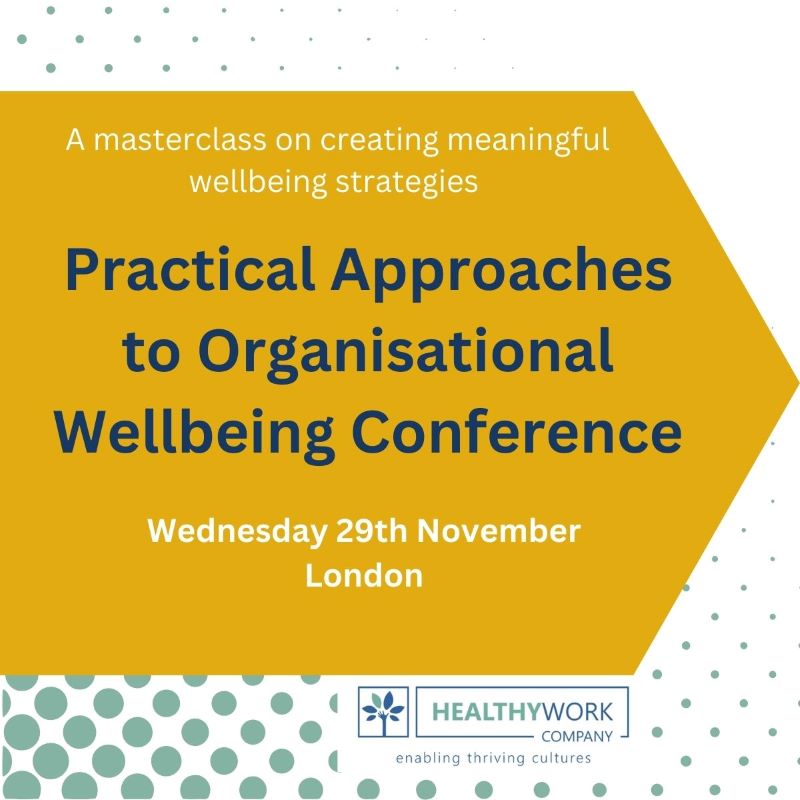Employers often focus on the health side of wellbeing. Nick Bell, Colin Powell, Peter Sykes and Val Scholey argue that businesses need to look beyond physical health to make sure employees are engaged and happy at work.
I was recently delivering some training in a very plush, purpose-built facility. In the foyer I saw what appeared to be an arcade machine. It turned out to be a device for assessing wellbeing. It had weighing scales, a cuff for measuring blood pressure and a touch screen interface.
The device took me through a series of questions about various aspects of my life, such as the hours I sleep, my diet, alcohol and smoking habits and exercise regime. It asked a few questions about how satisfied I felt with my life. After measuring my blood pressure, weight and height, I was sent on my way with a little printout telling me my ticker is probably OK but I could benefit from losing a bit of weight.
This encounter highlighted that we seem to use ‘wellbeing’ as a shorthand for physical and/or mental health. This is a logical starting point in the health and safety profession. Each year we are losing 23.5 million days due to ill-health, compared to 4.7 million days due to injuries. While we are rightly appalled that we killed 133 people at work in 2013/2014, this figure pales in comparison to the 8,000 who (based on 2005 data) die each year from work-related cancers. [1] The demographics of our society are also changing. Employers and government are having to manage an ageing population, and there are huge incentives to help people remain economically active (and away from hospitals and social care) for as long as possible. [2]
Wellbeing is, however, a much broader concept than how healthy we feel (although that is part of the equation). [3,4] The World Health Organization (WHO [5]) proposes that wellbeing is a state in which:
“Every individual realises his or her own potential, can cope with the normal stresses of life, can work productively and fruitfully, and is able to make a contribution to her or his community.”
There is broad agreement with this definition [6,7,8] even though academics cannot agree on whether we should be using the term wellbeing or well-being. [7]
Beyond physical health
As my encounter with the machine demonstrated, some aspects of physical health are relatively easy to measure and even to promote. Wellbeing initiatives can include free or subsidised gym membership, healthy eating campaigns, private healthcare, free health checks (or health MOTs), encouraging cycling by providing bike shelters and showers and so on.
Larger organisations may offer some of these options as part of a flexible package of benefits that employees can choose as their circumstances change (often with some tax benefits).
These initiatives could improve people’s perception of their own physical health and help them to ‘work productively and fruitfully’. Unilever estimates that they save between three and five euros for every one euro spent on employee safety, health and wellbeing. [9]
While these physical health initiatives can be visible and beneficial, they may be best seen as ‘nice to haves’. If staff are working incredibly long hours, in a job they find unfulfilling, with a team that doesn’t talk to each other and a boss who has scant regard for their ideas or abilities, their wellbeing won’t be particularly high. In these circumstances, physical health initiatives can look like a cynical effort to ‘buy’ their commitment or can aggravate staff who have too little energy or time to use these schemes. Providing workers with an employee assistance programme (which usually comes in the form of a helpline) is not going to resolve the underlying problems.
Many organisations have a swathe of data which could give an impression of the state of worker wellbeing: Staff absenteeism, turnover, grievances and so on. However, these are reactive and unreliable measures. For example, people can drag themselves into work despite feeling unwell. [10,11] Employers who are interested in worker wellbeing need to dig deeper.
Doing wellbeing at work
The HSE’s stress management standards (which are explained in HSG218 [12]) can be a very useful place to start with wellbeing. The standards touch on many elements of the WHO’s definition of wellbeing: Do workers feel that they have sufficient time and skills to do their work? Do they feel supported? Do they have control over their working arrangements?
Asking these questions (perhaps in the form of a staff satisfaction survey or in focus groups) can give a snapshot of wellbeing across an organisation. They can throw up both uncomfortable revelations and valuable solutions if they are managed well. I once had the misfortune to see a manager give his team a dressing down for their low scores in a staff satisfaction survey.
Wellbeing at work is largely about building on the simple foundations discussed in HSG218. For example, work should be well planned and adequately resourced and the abilities of staff should be considered when allocating them to projects. As a result, staff are likely to feel that they are able to work productively.
Work is only one aspect of wellbeing, which also depends upon people’s feelings about themselves, their family and social environment. [13] However, employers can have a massive influence over these other aspects by, for example, ensuring that workers have a reasonable work-life balance.
Going beyond the basics
Building on these foundations, better organisations allow staff to set the agenda for their own development, and provide opportunities for them to learn the skills to progress within their organisation and career. This may take the form of formal training but could include job rotation, shadowing and mentoring to help workers grow in knowledge and confidence and find where their strengths and interests lie. Staff may then feel that they are reaching towards their potential.
Workers can also be supported (and trusted) to have higher levels of autonomy and influence over how their work and workplace are organised. This could range from writing and delivering a short tool box talk to leading a project to assess the maintenance implications of a proposed production line. All these measures promote ‘self-efficacy’: A belief in one’s own abilities and competence which is another element of wellbeing. [6]
Staff will struggle to work productively and reach towards their potential if they perceive that their manager is unsupportive or, worse, a bully. In our efforts to improve worker wellbeing, there is a strong case for developing managers’ soft skills. [14,15] Transformational leadership qualities, such as managers’ ability to listen to their workers, create a compelling vision, nurture talent and recognise workers’ contributions, are recognised to improve both health and safety and wellbeing. [16,17] These managers will elicit and value workers’ insights, which enhances workers’ self-worth as well as finding better ways of organising work. Team meetings and joint projects can also be used to encourage collaborative working, promote better relationships at work and find solutions to workplace problems.
Many of these measures are very similar to the factors which promote high levels of worker engagement. [18] This is of little surprise: Engagement is one measure of wellbeing. [19] Improvements to engagement and wellbeing will largely go hand-in-hand. As engagement is linked to increased productivity, innovation and profitability [19] there is a business case for an employer to examine the engagement and wellbeing of their staff.
Employers can promote a sense of belonging to a community by actively supporting voluntary contributions by employees, perhaps including involvement with professional bodies.
Wellbeing is subjective and there is no one-size-fits-all solution. For example, I was facilitating a discussion about wellbeing and one delegate expressed how much she and her family had enjoyed family days run by a Japanese-owned company. For her, it gave a genuine sense of belonging and indicated how much the company cared. Another delegate immediately said how much he disliked those events as he believed they were contrived and impinged on his free time.
Wellbeing at work has to start with an employer genuinely caring about their employees and recognising that their workers are a collection of individuals. It’s important that wellbeing isn’t simply confined to initiatives around maintaining or promoting physical health (although these are simple, visible and beneficial schemes). Instead, organisations should consider whether there are fundamental issues about how work is organised and managed which may be promoting or undermining employee wellbeing. The HSE’s stress management standards are a good starting point but, in discussion with staff, more innovative solutions may emerge. In particular, workers can have greater involvement in or control over the organisation of their work and workplace.
Nick Bell, CFIOSH, runs his own risk consultancy, Dr Colin Powell is a member of the academic team and Dr Peter Sykes is a principal lecturer at Cardiff School of Health Sciences, Cardiff Metropolitan University, while Val Scholey is a principal practitioner for Healthy Working Wales
References:
- HSE (2014). Health and Safety Statistics: Annual Report for Great Britain. Available at: http://www.hse.gov.uk/statistics/
- Vaughan-Jones H. and Barham L. (2009). Healthy Work: Challenges and Opportunities to 2030. Bupa: London.
- Dewe P., O’Driscoll M. and Cooper C. (2012). Theories of Psychological Stress at Work. In Gatchel R. and Schultz I. (Eds) (2012). Handbook of Occupational Health and Wellness. Springer.
- Kuoppala J., Lamminpaa A. and Husman P. (2008). Work Health Promotion, Job Well- Being, and Sickness Absences – A Systematic Review and Meta-Analysis. American College of Occupational and Environmental Medicine 50(11) pp 1216-1227.
- World Health Organization [WHO] (2013). Mental Health: A State of Well-being. Available at: http://www.who.int/features/factfiles/mental_health/en/
- Huppert, F., Marks, N., Clark, A., Siegrist, J., Stutzer, A., Vittersø, J. and Wahrendorf, M. (2009). Measuring Well-being Across Europe: Description of the ESS Well-being Module and Preliminary Findings. Social Indicators Research, 91, 301-315.
- Dodge R., Daly A., Huyton J. and Sanders L. (2012). The Challenge of Defining Wellbeing. International Journal of Wellbeing. 2(3) pp 222-235.
- La Placa V., McNaught A. and Knight A. (2013). Discourse on Wellbeing in Research and Practice. International Journal of Wellbeing. 3(1) pp 116-125.
- Unilever (2014). Employee Safety, Health and Wellbeing. Available at: http://www.unilever.com/sustainable-living/betterlivelihoods/Respecting-Humanrights/well-being/
- Cancelliere C., Cassidy J., Ammendolia C. and Cote P. (2011). Are workplace health promotion programs effective at improving presenteeism in workers? A systematic review and best evidence synthesis of the literature. BMC Public Health. 11(395). Available at: http://www.biomedcentral.com/content/pdf/1471-2458-11-395.pdf [Accessed 26.06.14]
- Chartered Institute for Personnel and Development (CIPD) (2014). Absence Management: Annual Survey Report 2014. CIPD: London.
- HSE (2007). Managing the Causes of Workrelated Stress: A Step-by-Step Approach Using the Management Standards, HSG 218, 2nd edition, HSE Books. Available at: http://www.hse.gov.uk/pubns/books/HSG218.htm
- Toor, S. and Ofori, G (2009). Authenticity and its influence on psychological wellbeing and contingent self-esteem of leaders in Singapore construction sector. Construction Management and Economics, 27, 299-313.
- Brun J., Biron C. and Ivers H. (2008). Strategic Approach to Preventing Occupational Stress. RR577. IRSST: Quebec.
- Hassard J., Wang D., Cox T., Muylaert K., Namysl A., Kazenas A., Flaspoler E. and Podniece Z. (2012). Motivation for Employers to Carry Out Workplace Health Promotion: Literature Review. Publications Office of the European Union: Luxembourg.
- Jeffrey K., Mahony S., Michaelson J. and Abdallah S. (2014). Well-being at Work; A Review of the Literature. New Economics Foundation: London.
- Bell, N., Powell, C., Sykes, P (2015). Transformational Leadership, Safety and Health Practitioner, April 2015. Available at: https://www.shponline.co.uk/transformational-leadership/
- Bell, N., Powell, C., Sykes, P (2014). Give and Take, Safety and Health Practitioner, December 2014. Available at: https://www.shponline.co.uk/give-take-workerengagement/
- Schaufeli, W (2014). What is engagement, in C. Truss, R. Delbridge, K. Alfes, A. Shantz and E. Soane (eds.). Employee Engagement in Theory and Practice, Oxon: Routledge.
Wellbeing CPD Spotlight
1. The main problems identified with many ‘wellbeing’ programmes are:
a) They are only concerned with attending a gymnasium
b) They are only concerned with physical health
c) Only work satisfaction is considered
d) Physical health initiatives can be viewed cynically by employees
2. It is estimated that in the UK we lose 23.5 million working days through:
a) Accidents at work
b) Injuries at work
c) Ill-health
d) Unknown causes
3. It is estimated that in the UK the number of people who die from work-related cancers per year is:
a) 133
b) Half a million
c) 8,000
d) 500
4. Physical wellbeing initiatives can include:
a) Healthy eating campaigns
b) Encouraging cycling to work
c) Free or subsidised gym membership
d) Free health checks
5. Physical health initiatives won’t address the following:
a) An unfulfilling job
b) Working long hours
c) Enhancing physical fitness
d) A boss who has little regard for others’ abilities or ideas
6. HSE’s stress management standards address issues such as:
a) Do employees feel that they have sufficient time and skills to do their jobs?
b) Do they have any control over their working arrangements?
c) Do they have high levels of salary?
7. One element of wellbeing is a belief in one’s own abilities and competence.
a) True
b) False
8. Transformational leadership qualities include:
a) The ability to empower workers
b) The ability to listen to workers
c) Recognising workers’ contributions
d) Giving generous pay rises for people they like
9. All workers will appreciate the value of initiatives such as family fun days.
a) True
b) False
10. To promote wellbeing, organisations should consider issues such as:
a) How quickly work can be done by employees
b) Imposing the same initiatives on all employees
c) How work is organised and managed
d) Giving staff more involvement or control over how their work is organised
Answers:
- b, d
- c
- c
- a, b, c, d
- a, b, d
- a, b
- a
- b, c
- b
- c, d























Health and safety should be a critical priority for businesses of all sizes. The wellbeing and safety of employees is vitally important for business and can have a significant impact on all operations. The workplace has a significant impact on people’s health and wellbeing. As such, employee wellbeing goes far beyond just minimising health issues and health-related absence. Wellbeing at work refers to all aspects of work, the internal work environment and work safety, and employee’s attitude towards their work, environment and organisation. To take better care of employees, promoting well-being activities, starting also by determining the level of well-being… Read more »